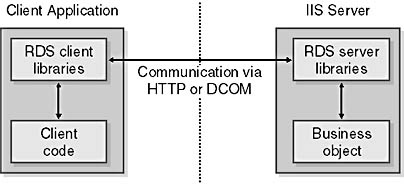What Is RDS?
RDS is a series of components that allow client applications anywhere on the Internet to communicate with business objects running on internal servers. When you use RDS in a client application to instantiate a business object running on another server, you don't get the object itself. Instead, you receive what amounts to a pointer to that object. The actual object will continue to reside on the server. RDS then acts as a middleman. When your client code accesses the pointer to your business object, RDS receives the request, packages it, and sends it to the RDS server components. Then the RDS server components access the business object, package the results, and return them to your client code. This process is shown in Figure 16-1.

Figure 16-1 Client/server communication through RDS.
Two RDS components run on the client: the DataControl object, which we'll discuss momentarily, and the DataSpace object, which we'll cover later in the chapter. If you want to run a query against a database, you can assign a connection string and a query string to the DataControl object, and the DataControl object will return an ADO Recordset object with the desired data. If you want to access a business object running on your Internet Information Services (IIS) server, you can use the DataSpace object to return a pointer to that business object.
RDS also includes a server component called the DataFactory object, which you'll learn about in the second half of this chapter. The DataFactory object provides functionality similar to the DataControl object. The library for the RDS server component is called RDSServer to differentiate it from the client components.
Another RDS feature we'll discuss is that it allows you to use handlers to control data access through the DataControl object. You can use handlers to restrict access to your database and to simplify your code.
Finally, as an alternative to using the RDS objects, Microsoft Data Access Components (MDAC) includes an OLE DB provider that provides functionality that closely resembles the DataControl object.
Let's take a closer look at the first of these features, the DataControl object.
EAN: N/A
Pages: 131